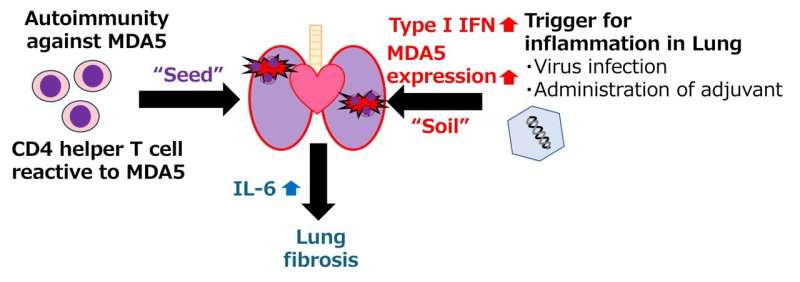This article has been reviewed according to Science X's editorial process and policies. Editors have highlighted the following attributes while ensuring the content's credibility:
fact-checked
peer-reviewed publication
trusted source
proofread
Successful murine model of dermatomyositis reveals underlying immune system involvement

Some diseases involve autoimmune reactions when the body begins to attack its own cells and proteins. The biological mechanisms underlying these diseases are often unknown, making treatment challenging. Now, a group at TMDU has created a murine model for a disease known as "anti-MDA5 antibody-positive dermatomyositis." The use of this model has allowed them to identify components of the immune system that are vital in disease development, with implications for future treatments.
Dermatomyositis is a member of a disease group known as idiopathic inflammatory myopathies, which cause typical rashes and muscle weakness, leading to disability and premature death. As part of the normal immune response, the body produces proteins known as antibodies, specific to individual "antigens" or foreign substances.
However, autoimmune reactions involve the abnormal production of antibodies to human proteins, called "autoantibodies." Anti-MDA5 antibody-positive dermatomyositis involves the production of autoantibodies against the protein MDA5, causing rashes, lung inflammation, and fibrosis, called interstitial lung disease (ILD). This often progresses very rapidly with a high mortality rate, and current anti-inflammatory treatments are ineffective.
"To develop a model of this disease in mice, we first triggered the production of anti-MDA5 autoantibodies," explains lead author of the study, Dr. Yuki Ichimura. "This resulted in the development of some lung inflammation but not full ILD."
Because MDA5 is involved in the body's response to certain viruses, the team then mimicked a viral infection in the lungs. The mice producing anti-MDA5 antibodies developed significant lung inflammation and fibrosis, emulating the pathogenesis seen in human patients and successfully modeling the disease.
The researchers then analyzed the specific immune responses occurring in the mice and investigated how these led to disease. Of the various cells involved in the immune response, they showed that cells called "CD4-positive T cells" are key for the development of ILD. Experimentally reducing the number of these cells lessened the lung damage observed. Autopsy findings from the lungs of patients back up the involvement of these T cells.
The research team went on to identify elevated levels of a signaling molecule called interleukin-6 in the murine model. "Experimental reduction of interleukin-6 levels ameliorated the development of ILD," explains senior author Dr. Naoko Okiyama, "indicating that medical intervention targeting interleukin-6 could be a potential treatment option for ILD."
The murine model developed in this study provides a key tool for investigating the mechanisms underlying anti-MDA5 antibody-positive dermatomyositis, the value of which is proved by the identification of key factors in the immune system involved in this highly progressive disease. Future work enabled by this study could aid in the development of more specific and effective therapies, improving treatment and quality of life.
The study is published in the journal Proceedings of the National Academy of Sciences.
More information: Yuki Ichimura et al, Autoimmunity against melanoma differentiation–associated gene 5 induces interstitial lung disease mimicking dermatomyositis in mice, Proceedings of the National Academy of Sciences (2024). DOI: 10.1073/pnas.2313070121



















